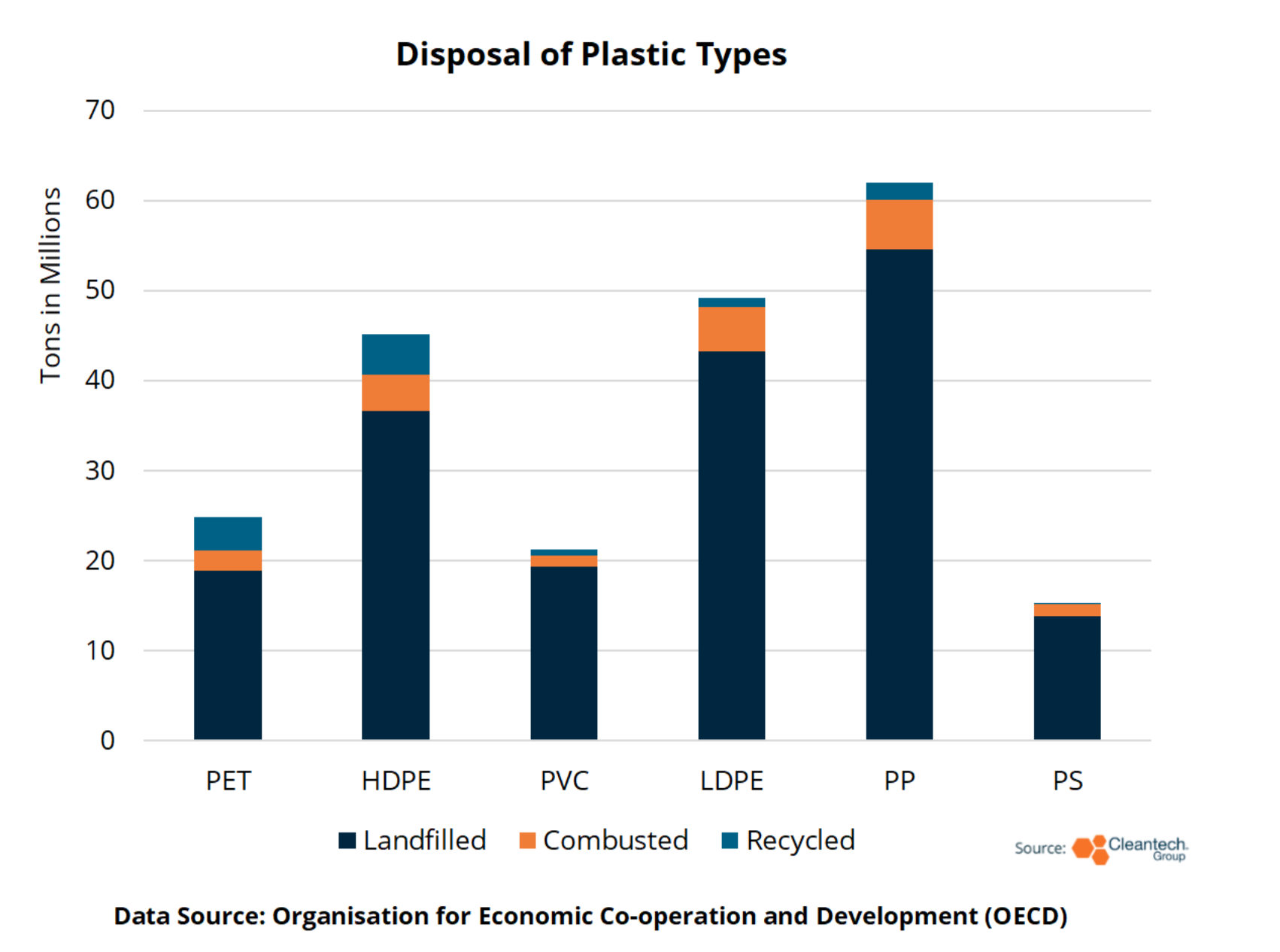Polypropylene (PP) is one of the most common plastic types in the world. In the U.S., PP plastic is marked with the number 5 plastic resin identification code on the bottom of packaging. It is the second most manufactured plastic after polyethylene, composing around 17% of annual global plastic production. As a food-safe plastic with high flexibility and puncture resistance, PP has extensive applications in snack and medication packaging as well as manufacturing.
Despite the diverse applications and demand for PP, its recycling rate is incredibly low. At just 3%, PP’s recycling rate is dwarfed by that of high-density polyethylene (10%) and polyethylene terephthalate (15%).

Acronym list: PET – Polyethylene Terephthalate, HDPE – High Density Polyethylene, PVC – Polyvinyl Chloride, LDPE – Low Density Polyethylene, PP – Polypropylene, and PS – Polystyrene. Type 7 excluded due to difficulty in tracing and high variation in category of plastic.
PP recycling presents several challenges that the incumbent plastic recycling technology (mechanical recycling) is simply not prepared to handle. As PP is sensitive to high heat, it often loses significant chemical integrity, strength, and flexibility during the extrusion process of mechanical recycling. Beyond this, recycled PP often has a substandard melt-flow rate (MFR), molecular weight, and thermal stability compared to virgin PP, due to contamination or degradation during the recycling process.
Due to the high regulatory standards for food-safe plastic, this recycled PP is often unsuited for most market applications. Some companies add virgin PP or additives to improve the quality of recycled plastic, but these solutions do not reverse the material degradation of PP. Within 2-3 recycling cycles, the original PP would be unusable in nearly all applications. This is not a circular resource nor is it true recycling.
Beyond chemical degradation, the economics of recycling PP remain daunting. The price of recycled PP is around 80% higher than virgin PP. Primary cost drivers here include the extensive testing/additives needed for food-grade certification, non-existent economies of scale for PP recycling, and expensive sortation. With companies unwilling to pay such a high premium, PP recycling has yet to benefit from large, dedicated recycling facilities and their economies of scale. While sortation is improving across plastic types, PP’s poor performance in mechanical recycling has kept it from being a focus of waste sortation innovators. A true chicken or egg scenario: for PP to receive improved feedstocks, novel recycling technologies must prove profitability.
Thankfully, solvent dissolution aims to fill that exact role for PP and several other plastics.
Innovation of Interest: Purecycle
Purecycle is an innovative American start-up utilizing supercritical butane, a new category of solvent capitalizing on properties of both liquids and gasses to improve plastic recycling. Solvent dissolution takes several forms but removes target substances from a specific polymer.
Purecycle licensed Proctor & Gamble’s technology removing impurities from PP. While Proctor & Gamble remain active in the solvent dissolution space, it is in a research capacity as they recently inked a joint agreement with Dow Chemicals to explore polyethylene recycling using solvents. Purecycle has gone on to establish the U.S.’ first commercial-scale solvent dissolution recycling plant in Ohio. With ongoing construction on a second, larger plant in Georgia to process a billion pounds of plastic per year, Purecycle aims to consolidate their hold over America’s recycled PP output.
With Europe’s more robust plastic recycling infrastructure, it is not surprising to see commercial ventures in solvent dissolution from APK (recently acquired by LyondellBasell) and Saperatec. Without the robust European sortation networks, Purecycle aggregated solutions to bring their supercritical butane solvent technology to commercial scale. They identified and expanded cheap, low competition, often contaminated PP feedstock to meet high demand for recycled PP. Supercritical butane became the perfect fit for this neglected feedstock. Able to maximize diffusion rates thanks to a low viscosity, supercritical butane is tuned with temperature and pressure to selectively remove contaminants from PP.
While they remain expensive from a capital cost perspective, supercritical fluids are poised to fundamentally redefine perceptions on plastic recycling. Academic research has explored the use of supercritical water in depolymerization of polyethylene terephthalate or supercritical CO2 as a delamination technology for multilayer plastic.
Solvent dissolution offers the best path for commercialized plastic recycling that achieves true resource circularity for PP. Improving on the incompatibility with mechanical recycling, Purecycle offers a solution capable of recycling contaminated and mixed versions of PP while retaining the plastic’s chemical purity for all commercial applications virgin PP is used for. Already commercialized in the U.S., the company is now exploring patent licensing agreements with some of Asia and Europe’s biggest chemical players including Mitsui, SK, and TotalEnergies.


